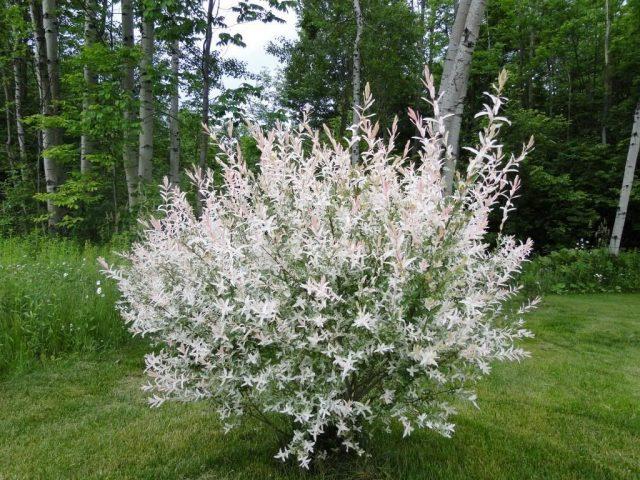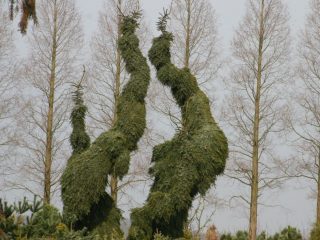Content
Willow Hakuro Nishiki is a beautiful low tree used in single plantings and when creating hedges, as well as in compositions. It has satisfactory winter hardiness and rapid growth rates. Willow has a symmetrical crown, wide and dense, so it needs pruning. The basic rules for growing are described in detail in the article.
Description of willow by Hakuro Nishiki
Willow Hakuro Nishiki is very different from a number of other representatives in that it gives a pleasant aroma that is reminiscent of hyacinth flowers. In addition, the plant is not a tree, but a perennial shrub that grows to a height of 2-3 m. The willow spreads about 2 m wide. The growth rate is very high - about 70-80 cm annually.
The bark of the branches is gray-green in color, then turns gray. Willow has brown shoots with a hint of red. The branches of the Hakuro Nishiki tree first grow predominantly upward, and then spread out and form a crown in the form of a spherical fountain or fan.This is precisely what it provides for decorativeness.
The Hakuro Nishiki willow produces oblong foliage of unusual color with a pale pink tint. At the same time, over time, the leaves turn green. By autumn they begin to turn yellow and completely fall off. As a rule, the most mature leaf blades become dark green, olive, and have purple streaks.
Willow Hakuro Nishiki is distinguished by early flowering, which begins in April, almost simultaneously with the appearance of the first leaves. The tree produces catkins of a dark purple hue that exude a floral aroma.
How to plant willow Hakuro Nishiki
Willow variety Hakuro Nishiki grows well in lighted, open areas with free air flow. She prefers light and fertile, well-moistened soils. Loose loam with a neutral or slightly acidic reaction pH = 6-7 is best suited.
Also, when planning to plant a Hakuro Nishiki tree, you should take into account that willow does not like wetlands that are located in lowlands or with high groundwater levels. It is best to plant a tree on a hill where there is no stagnation of melt or rain water. Also, if possible, the planting site should be protected from strong winds, especially on the north side of the garden.
Seedlings are purchased from nurseries, from suppliers with good reviews and many years of experience. As a rule, they come with a closed root system, i.e. in a small pot. It is necessary to carefully examine the shoots and trunk. They should not show signs of damage or rot.

Willow grows well in sunny areas
Planting of Hakuro Nishiki is planned for the second half of spring - from late April to mid-May. You can also plant it in the fall until the end of September in order to catch it before the onset of frost (at least 30 days).In this case, the site is prepared in advance:
- Clears away debris.
- Dig to the depth of a spade bayonet.
- Fertilize with humus or compost (a bucket per square meter).
- Mark several holes 60x60 cm at a distance of at least 2 m. You can take an interval of 1 m - then you will get a hedge (if you plant seedlings in rows).
- Fill with fertile soil.
Then they proceed directly to planting the Hakuro Nishiki willow seedling. It is recommended to first soak the roots overnight in a solution of a growth stimulator, for example, Zircon. Then the seedlings are placed in the center and the roots are straightened. Dig in some soil and tamp down a little so that the root collar remains flush with the surface.
Give one bucket of settled water and mulch after a few days (in case of autumn planting). To do this, use straw, hay, sawdust, or peat. In early spring, the mulch layer is removed, the soil is loosened and care continues.
Willow care Hakuro Nishiki
The whole-leaved willow Hakuro Nishiki is not demanding of care and grows normally in the climatic conditions of Russia. It is important for it to ensure regular watering, since the crop requires constant moisture. Where willow grows, you should ensure that the soil does not dry out. Periodically, the soil is loosened and dug up in the fall. If necessary, remove weeds.
Another rule for growing Hakuro Nishiki willow is fertilizing. It is advisable to give them three times per season - in the spring, add ammonium nitrate or urea at a rate of 20 g per square meter. The granules can be scattered over the surface or dissolved in 10 liters of water. Typically, an adult tree requires 2-3 buckets.
The second time is fed in mid-summer. Willow needs complex mineral fertilizer, for example, azofoska.In September, it is recommended to feed Hakuro Nishiki with wood ash.
How to prune a willow tree by Hakuro Nishiki
To properly grow a tree, it is necessary to do sanitary pruning of the Hakuro Nishiki willow every spring. At the end of March, weakened, frost-damaged shoots are removed. They appear almost every year, but do not threaten trees. It is necessary to trim the affected branches to a healthy place, and then sprinkle the cut areas with charcoal.

The crown grows quickly, so pruning should be done even in summer
All dry, old branches, as well as those protruding beyond the general contour, are removed in the fall, after the leaves fall. The willow crown grows very quickly, so it has to be thinned periodically in the summer, especially when growing a hedge. It is necessary to remove all shoots that grow inside the crown, making it too thick.
With the help of proper pruning of the Hakuro Nishiki willow, you can also make a standard. This should also be done in the spring, but only after flowering - from late April to early May. The sequence of actions is as follows:
- Mark the height of the stem - about 120-150 cm.
- Sharpen and disinfect pruner blades with a solution of potassium permanganate 1 g per 1 liter.
- Shorten the shoots on the trunk within the intended height and leave stumps 10-15 cm.
- Leave a bud looking up or to the side - it will give rise to a shoot that will bend beautifully when germinating.
- After 1.5-2 months, when the branches begin to fall to the ground, repeat the pruning of the willow by Hakuro Nishiki.
Shelter for the winter
When organizing care for the Hakuro Nishiki willow in the Moscow region, other regions of the middle zone, especially in the Urals and Siberia, it is necessary to provide shelter for the winter. The soil is thoroughly mulched with sawdust, hay, straw or other materials, and the graft site is covered with burlap.
Pest and disease control
In general, the Hakuro Nishiki willow is quite resistant to diseases and pests, but with excessive watering, as well as in rainy summers, it can suffer from fungal infections. For prevention, fungicide treatment is carried out in early spring:
- "Maksim";
- "Abiga Peak";
- "Ridomil Gold";
- "HOME."
For willow pennies, poplar or aspen leaf beetles, they are treated with insecticides:
- "Aktara";
- "Fufanon";
- "Inta-Vir";
- "Match".
Willow propagation by Hakuro Nishiki
The Hakuro Nishiki willow can be propagated by cuttings, as well as by grafting onto a standard. The first method is simpler, the second is somewhat more complicated, but also quite feasible. The main steps and practical tips are described below.
Willow cuttings by Hakuro Nishiki
To propagate the Hakuro Nishiki willow from cuttings, work should be planned in early spring, before the buds begin to bloom. The sequence of actions is as follows:
- Cut several cuttings from last year's branches 12-15 cm long.
- Make the bottom cut oblique and the top cut straight.
- Then immediately dig into fertile soil (up to half the length).
- Pour over and cover with a transparent jar.
- Continue to water and ventilate periodically.

Cuttings should not be too long
How to graft willow Hakuro Nishiki onto a standard
Another way to propagate a tree is to graft it onto a trunk. To do this, choose a 2-3 year old seedling as a rootstock. The apical shoots of different varieties of willow are taken as a scion (i.e., a layer that is grafted onto the rootstock):
- creeping;
- whole leaf;
- hairy;
- red.
The sequence of actions for grafting onto the willow trunk of Hakuro Nishiki is as follows:
- They grow a standard in advance - remove all side branches and wait for the tree to reach the desired height.
- A cutting with 3-4 live buds is prepared at the end of April.
- Using a sharp knife, cut off the apical part of the trunk on the trunk and make a split.
- Then make an oblique cut on the scion exactly above the upper bud.
- Form a sharp wedge at the bottom.
- Carefully insert the Hakuro Nishiki willow graft into the split.
- Treat with garden varnish and wrap with tape.
- Organize good care - watering, fertilizing, loosening. Exactly one year later, the tape can be removed - by this time the graft will have taken root long ago.
This is a mandatory requirement for all regions, including the middle zone, the Black Earth Region and southern Russia.
Iwa Hakuro Nishiki in the landscape
The tree is very attractive due to its unusual crown and compact size. Often the Hakuro Nishiki willow is used in single plantings; it is planted mainly in courtyards, in open areas, next to a house, a pond, or a bench. It can also be used in combination with other plants, formed into a trunk or hedge.
Several options for using Hakuro Nishiki willow in landscape design:
- Green Alley.
- Willow on a trunk.
- Single planting next to flowers.
- Another example of growing a trunk.
Conclusion
Iva Hakuro Nishiki is quite suitable for the climatic conditions of Russia. This is an unpretentious tree, from the crown of which you can form a beautiful ball or a kind of green “fountain”. To do this, it is necessary to regularly prune and fertilize several times a season.
Reviews of willow Hakuro Nishiki












